Dear Artist,
A lifetime ago, when I first visited the mother of a friend in upstate New York, I noticed a small watercolour, hung in the hallway on the lower level of her house. The painting was a spare tangle of chaotic but organized marks in a limited, sombre palette with flashes of yellow. Directionless but self-directed, and a jumble at first glance, it also stood independently as something quietly totemic — a miniature of a primordial rage and exaltation, and also inviting consideration as a study in colour and paucity. When I closed in to look at the signature, there, in pencil, was scrawled “Joan Mitchell.” Each time I visited thereafter, I checked in with it — it became a kind of beacon of painterly independence, a casual treasure tucked amongst others in the basement of a real and independent New York woman. The thing about New York was that its myths were always revealing themselves as real; like a drip for an ailing dreamer.
Joan Mitchell was the daughter of a Chicago dermatologist and a poet — an active girl who loved diving and skating and who attended Saturday art classes at the Art Institute of Chicago. She studied art at Smith College in Massachusetts and the Art Institute, and in 1947 moved to New York, where she attended a wordy class of Hans Hofmann’s but promptly left, terrified. Instead, she used a fellowship to go to France and Spain to paint. She married a prominent American publisher. When she returned to New York, she joined in with a downtown scene of fledgling ab-exers, developing a personal and surprising, to others, physicality in the form of large, unwieldy paintings. By 1951, she was exhibiting in Leo Castelli’s landmark Ninth Street Show alongside Pollock, de Kooning and Hofmann. The following year, she had a solo at the New Gallery and got divorced. By the mid-fifties, Joan, while enjoying success in New York, was spending more time in France. There, she met Canadian expressionist Jean-Paul Riopelle. They fell in star-crossed love, married, set up separate homes and studios and met nightly for dinner.
Joan, who hated aesthetic labels, nevertheless lived her life under the mantle of abstract expressionism and described her work as drawn from the landscape and natural forms. “I carry my landscapes around with me,” she said. She likened her work to poetry over prose, allowing composed palettes to imply a sense of consciousness to otherwise primal strokes. She referenced the aerial landscapes she saw growing up in a highrise in Chicago and the brushy colour riots she admired in the work of her favourite painter, Matisse. She preferred her sunflowers to be dying; or Van Gogh’s. Even within these loose handles, Joan’s paintings invite standing on their own; eschewing explanation in favour of independence from context. They are, at times, confrontational in their chaos, and also cunningly ordered. When she inherited some money after the death of her mother, Joan bought a two-acre estate in Vétheuil, near Giverny. There, a deeper pastoral spirit appeared — a Monet-esque wide-angled-ness. Where there was once a youthful stabbing of marks, tornado scribbles and sledgehammer strokes, a soft calligraphy emerged as the dominant energy. Joan lived and worked in her Vétheuil retreat from 1967 until her death in 1992.
Sincerely,
Sara
PS: “Abstract is not a style. I simply want to make a surface work.” (Joan Mitchell)
Esoterica: “A painting is not part of me,” said Joan. “Because when I do paint, I am not aware of myself. It is part of something else. Communication is very difficult.” In this way, she detached from any urge to make a narrative of her life in her art, but rather let her paintings work independently as stand-alone pieces of aesthetic expression. “It seems very clear what it means. I can’t say it but the painting makes it clear. If I don’t know, then it’s not working,” she said. “If it seems right to me, then it has a meaning, but I can’t tell you what meaning. I can’t be more specific than that. It works when it means something, when I don’t question it any more.”
For the first time in nearly 20 years, Joan Mitchell is the subject of a major U.S. survey, at the San Francisco Museum of Modern Art. The exhibition includes over 80 canvases and is on view until January, 2022.
Have you considered a Premium Artist Listing? With each letter, an artist is featured at the bottom of this page. The Premium Artist Listings are a means of connecting artist subscribers through their work. Proceeds from each listing contribute to the production of The Painter’s Keys.
“Painting is the only art form except still photography which is without time. Music takes time to listen to and ends, writing takes time and ends, movies end, ideas and even sculpture take time. Painting does not… It’s a still place. It’s like one word, one image.” (Joan Mitchell)
Featured Workshop
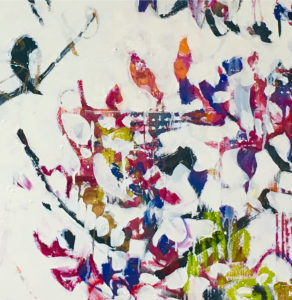 Join Ellie Harold for “Intuitive Painting: Permission to Paint Expressively,” designed especially for mature women artists of all skill levels who wish to explore this medium for soulful exploration. The retreat provides attractive accommodations (your own room!) along with lightly structured activities for centering, relaxation and low stress art-making. You’ll have plenty of free time to muse, paint, write and reflect while enjoying the colors, textures and flavors of San Miguel. This Retreat has the potential to transform not only your art but your life! You’ll return home with a specific art “care plan” to assure support for further creating. Details at www.EllieHarold.com.
Join Ellie Harold for “Intuitive Painting: Permission to Paint Expressively,” designed especially for mature women artists of all skill levels who wish to explore this medium for soulful exploration. The retreat provides attractive accommodations (your own room!) along with lightly structured activities for centering, relaxation and low stress art-making. You’ll have plenty of free time to muse, paint, write and reflect while enjoying the colors, textures and flavors of San Miguel. This Retreat has the potential to transform not only your art but your life! You’ll return home with a specific art “care plan” to assure support for further creating. Details at www.EllieHarold.com.
Featured Artist
We live in a fractured world. Wars, famine and power games are forcing people to abandon their homes and their way of life in hopes of finding peace. For lack of education or specialized skills, the poor are not accepted into our northern communities. They stay in the camps on the borders of turmoil, separated from local community. Animals are caught in the crossfire. Even the trees and the rocks suffer the agony of imbalance. This chaos is evident in my work. In between the rivulets of paint and the textural accidents I choose colours and forms to suggest a landscape where beauty continues to reign. We can still change the tide and build a new world harmony. Certainly, contemporary will focuses on gold instead of beauty. Yet, beauty is essential to the wellbeing of the planet. She is essential to the survival of humanity.

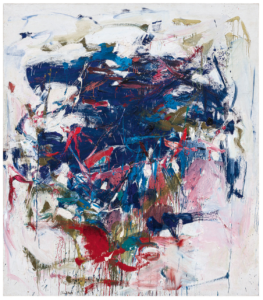
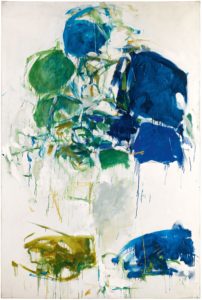
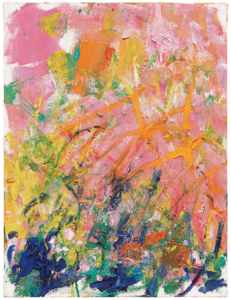

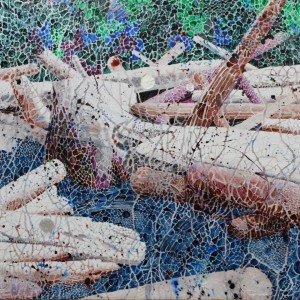



21 Comments
Thank you, Sara, for this background and history. I am going to see Joan Mitchell’s exhibit in November, and I appreciate learning more about her & her work before going.
What an amazing story, including your “discovery” of the watercolor! I’ve always admired Mitchell’s work, seen a good number of piece up close and personal, only vaguely understood what she was doing but always responded viscerally to the work. Your noting the ties to Matisse and Monet bring me an a-ha moment; thank you.
Thank you for this! I am transiting through San Francisco in late October – and what a great reason to stay an extra day.
Under the radar.
Yet she is now emerging without any fuss other than a lot of painting.
Thank you. I will research her a bit more.
Ninth Street Women is a good read and describes a lot about her life and other Ab-Ex women artists like Helen Frankenthaler.
thank you for this one. soothing and inspiring and heartening. love it
I’ve felt a connection with Joan Mitchell’s painting for a number of years now. Seeing her work in the large Women in Abstract Expressionism show gave me permission to let go into my own autonomous mark-making. I’ve often had the sense of something Larger than Myself using the brush and those intuitive marks to communicate–for those who have eyes to see. Yet, the way art is displayed in galleries and museums so often mitigates against that kind of visual perception. I attended a juried show opening last night at a lovely museum where the exhibit brochure actually listed the entries under the title “Checklist.” Indeed, I could see people checking off, with the pencil provided, the pieces they breezed by. Exploring the notion of “slow looking,” I’ve learned that the average length of time a painting is viewed–including master works–is 17.2 seconds! The mysterious communication of art like Joan Mitchell’s (and my own) requires time spent in front of it, gazing, to allow the communication the artist has channeled to make an impression. A big reason I prefer selling my art and not simply exhibiting it (especially in shows filled with “apples and oranges”) is that hanging on a collector’s wall, it’s more likely the art may actually be seen and the communication revealed and received.
The house Joan Mitchell bought in Vétheuil sits immediately above and behind the smaller house that Monet lived in with his wife Camille and 2 young sons, plus the entire Hoschedé family of 8! (This was when they were all broke in 1877.) Camille died there in 1879 and is buried in the courtyard. Ernest Hoschedé left his family, and after his death in 1891 his wife Alice married Monet.
Across the street from Monet’s home and garden in Giverny there is a small museum, and it was there that I saw an 8 foot square painting by Joan Mitchell that blew my mind: La Grande Vallee IX.
A beautiful addendum. Thank you.
Sara, thank you for this surprising and lovely essay on Joan Mitchell. She has long been an icon for me, in fact ever since I saw her enormous triptych at the Pompidou.
Dorothy
Such a lovely surprise for a Friday and this piece and Joan Mitchell’s art slowed me way down — no 17.2 seconds on this one. How exciting to see women artists appearing in major exhibits, and Joan Mitchell deserves these wonderful comments and a long look at her work. Thank you so much, Sara!
Great essay, I have been focusing more on Joan Mitchell as the retrospective is also coming to Baltimore in March. Really looking forward to that visit!
I don’t paint like Joan, but Ithink of her when I paint.
Love her later work from France. I have a book about her. Fascinating woman. Thank you for sharing.
I included a photo of Joan Mitchell in her studio surrounded by her paintings with the quote “sunflowers are like people to me” in the lecture I gave this morning to our elementary students at Westfield Friends School. The lecture was called THE QUIET EYE. How timely was your article today and I am also happy to know that her retropective will come to the east coast in March. Thank you.
Thank you Sara for the text on Joan Mitchell and her art, which I’ve loved her work for years. She is one of the most inspiring artists and has captured so much passion and strength in her work. She is one of the master artists, one who would sit across the room from her work for hours quietly assessing until she knew where her next full force brush strokes would be placed. Your words about her work could not be better stated of how she worked and what she achieved in these amazing canvases and papers. She is an astounding colourist, her work is truly impacting and breathtaking!
Thank you Sara for this extremely lucid and useful mini-essay – it makes me want to find out more.
Wonderfully inspiring to learn more about Joan Mitchell and to view her paintings. Thank you Sara.
I had no idea Jean Paul Riopelle and Joan Mitchell were married. Their work speaks a common language of love and I appreciated how you described her wonderful expression of art. Thank you Sara.
Thank you, Sara, for a lovely introduction to an artist I was not familiar with. I so appreciate your gentle voice and always look forward to your letters.
Dear Sara,
Thank you for including a few of Joan’s paintings! I love that you can look at them zoomed-in close! Wishing to go to SF to see her show … maybe it will land in the Pacific NW someday!